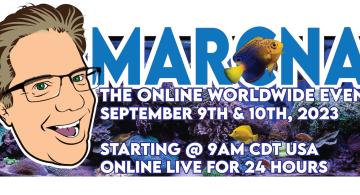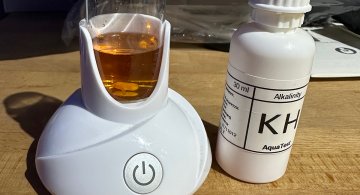MACNA XV: Louisville, KY
I had the opportunity to attend MACNA's 15th annual conference in in Louisville Kentucky. LMAS was the hosting club. This was my second time, as I attended the one in Ft Worth last year as well, hosted by DFWMAS (my local club).
MACNA (Marine Aquarium Conference of North America) is designed for the purpose of sharing knowledge with hobbyists. A person can gain much knowledge in three days, which is disseminated by various speakers of different fields. Plus, the newest innovations are on display, all types of livestock and dry goods are available, and you can hang out and talk with people in the same hobby!
Various pages (linked to the left) were put together to let you discover what you may have seen had you attended.
Here are some of the things I noted from the conference:
Skipper of Reef Central was in attendance, as were other regulars from that board. Every saltwater enthusiast seemed quite happy with this year's events.
Anthony Calfo showed up with a new book that I bought, called Reef Invertebrates that has to weigh at least 10 lbs, packed with pictures and commentary. I think it will be an excellent identification book. He received the Masna award for being the most helpful to the hobby this year. I agree that he deserved it, although there are many others that are worthy as well.
Nancy Swart, the former president of MASNA, officially retired this year, and she received an award for 10 years of volunteer service. Masna’s BOD set up a fund in her name that will help future clubs when they host MACNA, and LMAS contributed $2000 in that fund for next year!
LMAS was exhausted but happy, and did a really nice job. I believe there were close to 400 in attendance, and there was really never any quiet time for people to get bored. Speakers were kept on schedule, and the dual giant screens made the presentations very enjoyable.
The vendors that sponsored this event did a good job, and took the time to explain or demonstrate some of their products, including the newer ones. The Blueline Metal Halide ballasts were interesting to me, as they had what looked like RCA jacks for the power connections. Very small and compact, but pretty hot to the touch. Tons of moonlights were on display as well.
Mike Paletta's book Ultimate Reef Aquariums sold out quickly. but Champion Lighting continued to take orders for it at $27 each, and said they'd eat the shipping costs. I thought that was a nice touch, as this too is a heavy hardcover book. Paletta compiled 50 reef tanks from all over the place, going into their setups and more, so I didn't hesitate to order a copy. Within days of coming home, my personal copy arrived and the book is inspiring. A great addition to your reefing library.
Anthony Calfo had a "hands on" fragging workshop, and many people were given leather corals to cut up and mount on small pieces of LR. However, the diehards were quick to circle his table (which he abandoned wisely) to get some frags from the two larger SPS colonies. I scored a very nice piece of a type of Bird's Nest that I put in my tank, but it didn‘t make it. The new leather fraglet was extending polyps in the bag on the way home, and is still doing nicely.
At the banquet, we had a nice surprise Saturday night. Beneath random chairs, a taped-on card identified a prize, courtesy of Walt Smith. Many won a coral, which Harbor Aquatics had on display. However, under my chair was an index card that said "ROCK".... It turned out that I won a CASE of Aqua Cultured Fiji LR from Walt Smith - approximately 40 to 50 lbs worth!!! I took a bunch of pictures of my prize, which can be seen online in the MACNA pictures on my site. 14 rocks total were in my box, which I cured in a trashcan filled with fresh saltwater, because I figured they'd probably cause a cycle if I put them directly into my 55g's setup. They are really nice pieces, and it was a cool prize. Especially because I didn't win anything from the raffle this year.
Mako did NOT win the big prize like he did last year, but he won the IceCap 660 he needed. The two full tank setups went to local people from Kentucky/Indiana, which really is a good thing when you think about it. If I'd won the 120g Oceanic reef with sump etc.... I would have wanted to keep all 40 of those gorgeous clownfish. It was at this conference that I learned that will never be an option. In the end, you'll only have 2.
Here's some of the free stuff given out this year:
- Julian Sprung's Phosban. Each container could handle 150g, and contained the micromesh bag to use during treatment.
- Cyclop-Eeze Freeze-Dried food.
- Reef Fanatic t-shirts.
- Premium Aquatics t-shirts.
- MarineLand's Instant Ocean (10g) salt. And an event timer/reminder gizmo.
- Posters.
- Sample foods.
For sale, there were a good dozen vendors to shop from. I'd have to say that Champion Lighting had the most to sell, imo. They had lots of books, lighting, bulbs, Tunze streams (including the new Rock that hides the pump - new from Germany - and yes, I got several pictures of it), a demo of the SCWD in action, etc.
Harbor Aquatics had two nice tanks like last year, filled up with clams and SPS and a few ricordias and an orange Fungia that looked fake or dyed to me, but perhaps they were really that color. Joy did her best to accommodate all the demands put upon her, including holding Walt Smith's corals, LR, etc....
Several vendors sold little fraglets of SPS corals mounted on various bases. One had all of his frags on plastic golf tees, which he said were very popular with his local club members. The golf tee frags were 6 for $100, but on Sunday they were $10 each.
Most of the corals were bought up so quickly (really, within minutes) that I finally just gave up asking about pieces. They were sold, sold, sold. Very nice colors and shapes, $35 each. I saw some zoanthids for sale, but not too many.
The Sunday Raffle must have had over 100 winners of various items. Calcium Reactors; a full-blown Ro/Di with all the accessories you can imagine; all three sizes of the Sea Swirl; (2) 5 gallon buckets of C-Balance!!!; test kits; additives; t-shirts; jewelry; MACO online courses; $25 - $100 Gift Certificates from various online vendors; an AquaSpacelight setup with T-5 bulbs; a 24 (or 30") HQI 150w MH with dual VHO actinics; 150g bucket of Sea Salt; 120g FULL REEF SETUP; a Marineland Wavy-Tank (unknown gallons) setup; SCWD; B-Ionic; 2 different Fish Magazine subscriptions; 2004 Reef Life Calendars; various Books, our Macna XIV DVD set, and seriously many more items I'm just not recalling. I really wanted to win a Calcium Reactor. Oh well, I'll just have to build DJ88's (from Reef Central) DIY reactor one day after all.
Many attendees ate at some of the local restaurants in the area, which provided a view of the river separating Indiana from Kentucky. And the food was delicous! Others hung out by the lake, which was directly behind the hotel, and enjoyed quite a few brews and smokes as some played guitar. They even got Killian's Red for me!
I would have to say that it would be quite easy to dub Macna XV as the Year of the Seahorse. There were TONS of Seahorses at the conference, and people studied them, observing them closely. Many were a nice size, but we were warned they would grow to be 12-13" in size. One tiny Marineland Betta Bowl with an LED light above it housed a few one-day old baby dwarf sea horses, and I got a few shots of those microscopic guys. In that cup's worth of water, you could see tiny baby brine swimming in the water, the food source for those newly born Sea Horses. 2 seahorses were donated to the raffle. It was tempting to bring one home for my refugium, but I decided against it. A number of sites were listed, with a plethora of information to properly care for these creatures.
Mr DT himself was there, with his newer 3-part Live Phytoplankton formula. I talked with him for a while, and got a little information about his stuff. He did NOT make the new food with three cultures to prevent people from using DT's as their starter culture. He wanted to increase the food's quality and quantity of individual cells, and by using 3 different types, he's increasing that various sizes of cells for different eating organisms. This reminds me of the various micron sizes of Golden Pearls available, for example. His newer product line comes in an opaque bottle, to assure that you can tell if you've shaken it enough. There should be no green stuff stuck on the bottom of the bottle if shaken properly. It is important to keep this product refrigerated, and he ships it out in 1.5" thick styrofoam boxes to keep the temperature perfect during transit.
One wholesaler brought and set up a 3 tiered (and stair-stepped) set of tanks that fit into the corner. There must have been 12 aquariums in that display, and he had a lot of fish in these. Giant Hippo Tangs ( the blue one like in Finding Nemo), a fleet or two of Yellow Tangs, various Flame Angels, a couple of Clown Triggers, a number of White Flag (or Banner) fish - which I was told were completely reef-safe, btw - a large dog-faced Puffer Fish that looked like a Yellow Yam to me , and more.
Another guy had a 20g long filled with True Perculas ($10 each!!!), and Black Perculas for $25 each. Everyone wanted the black ones, which had cute little orange faces. I would have bought one for that look alone, but learned that the orange will go away completely. No thanks, I don't want a black clown. Apparently others do, like Anthony Patrick of our club, and were excited to find these at this year's show.
Daniel Knop, Walt Smith, Julian Sprung, Martin Moe, Anthony Calfo, and Mike Paletta were a few of the people in the industry I knew that gave presentations.
Btw, I found out that you can tell the sex of a Flame Angel by its size and its stripes. If it is large with many stripes, it's a male. Fewer stripes indicates its a female. And get this: From fertilized egg until you have a recognizable and properly colored Flame Angel, it takes 145 days! Before that, they don't look at all like these beauties we love to see.
One talk was about feeding to enhance color in your fish and corals. It talked about the food colorings included in various foods, including the very hot topic Cyclop-Eeze. They pay a lot to get that red color into their food, and that is why it costs us so much. But even more important is the fatty food cells, like HUFA 3. I didn't take notes on this talk, but apparently foods that have a low content of this amino acid really affect our fish adversely, and can lead to premature blindness! One thing you want to avoid doing is leaving your flake food (if you use that) on top of your canopy where the lights just cook your food. It will break down the good fats, and make the food essentially worthless in that area. Also, frozen foods contain fats as well, but even while it is in the freezer the fats continue to break down, and the food looses its value over time. Very interesting information.
The final talk of the conference emphasized the need for us, as clubs as well as individually, to get out there and educate others about the hobby. One focal point was to get a small reef setup in your local middle school classroom(s), to encourage these young minds to learn more about marine life. The speaker encouraged MASNA to organize some type of system that the clubs can implement under their direction. It was a good discussion, but I felt it should have been held earlier during the conference when our minds and bodies were less tired. This is an important issue and I fear it wasn't taken as seriously as some would have liked, such as Martin Moe for example. Oh yeah, Martin was there as well, his wife always nearby - having a great time.
















